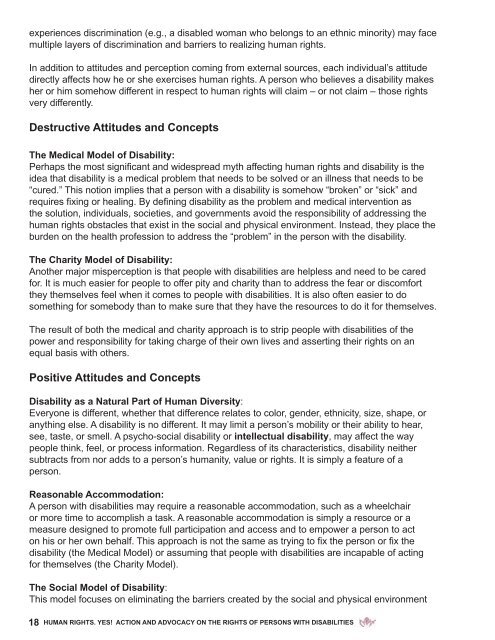Full page photo print - Harvard Law School Project on Disability
Full page photo print - Harvard Law School Project on Disability
Full page photo print - Harvard Law School Project on Disability
You also want an ePaper? Increase the reach of your titles
YUMPU automatically turns print PDFs into web optimized ePapers that Google loves.
experiences discriminati<strong>on</strong> (e .g ., a disabled woman who bel<strong>on</strong>gs to an ethnic minority) may face<br />
multiple layers of discriminati<strong>on</strong> and barriers to realizing human rights .<br />
In additi<strong>on</strong> to attitudes and percepti<strong>on</strong> coming from external sources, each individual’s attitude<br />
directly affects how he or she exercises human rights . A pers<strong>on</strong> who believes a disability makes<br />
her or him somehow different in respect to human rights will claim – or not claim – those rights<br />
very differently .<br />
Destructive Attitudes and C<strong>on</strong>cepts<br />
The medical model of <strong>Disability</strong>:<br />
Perhaps the most significant and widespread myth affecting human rights and disability is the<br />
idea that disability is a medical problem that needs to be solved or an illness that needs to be<br />
“cured .” This noti<strong>on</strong> implies that a pers<strong>on</strong> with a disability is somehow “broken” or “sick” and<br />
requires fixing or healing. By defining disability as the problem and medical interventi<strong>on</strong> as<br />
the soluti<strong>on</strong>, individuals, societies, and governments avoid the resp<strong>on</strong>sibility of addressing the<br />
human rights obstacles that exist in the social and physical envir<strong>on</strong>ment . Instead, they place the<br />
burden <strong>on</strong> the health professi<strong>on</strong> to address the “problem” in the pers<strong>on</strong> with the disability .<br />
The Charity model of <strong>Disability</strong>:<br />
Another major mispercepti<strong>on</strong> is that people with disabilities are helpless and need to be cared<br />
for . It is much easier for people to offer pity and charity than to address the fear or discomfort<br />
they themselves feel when it comes to people with disabilities . It is also often easier to do<br />
something for somebody than to make sure that they have the resources to do it for themselves .<br />
The result of both the medical and charity approach is to strip people with disabilities of the<br />
power and resp<strong>on</strong>sibility for taking charge of their own lives and asserting their rights <strong>on</strong> an<br />
equal basis with others .<br />
Positive Attitudes and C<strong>on</strong>cepts<br />
<strong>Disability</strong> as a Natural Part of human Diversity:<br />
Every<strong>on</strong>e is different, whether that difference relates to color, gender, ethnicity, size, shape, or<br />
anything else . A disability is no different . It may limit a pers<strong>on</strong>’s mobility or their ability to hear,<br />
see, taste, or smell . A psycho-social disability or intellectual disability, may affect the way<br />
people think, feel, or process informati<strong>on</strong> . Regardless of its characteristics, disability neither<br />
subtracts from nor adds to a pers<strong>on</strong>’s humanity, value or rights . It is simply a feature of a<br />
pers<strong>on</strong> .<br />
Reas<strong>on</strong>able Accommodati<strong>on</strong>:<br />
A pers<strong>on</strong> with disabilities may require a reas<strong>on</strong>able accommodati<strong>on</strong>, such as a wheelchair<br />
or more time to accomplish a task . A reas<strong>on</strong>able accommodati<strong>on</strong> is simply a resource or a<br />
measure designed to promote full participati<strong>on</strong> and access and to empower a pers<strong>on</strong> to act<br />
<strong>on</strong> his or her own behalf. This approach is not the same as trying to fix the pers<strong>on</strong> or fix the<br />
disability (the Medical Model) or assuming that people with disabilities are incapable of acting<br />
for themselves (the Charity Model) .<br />
The Social model of <strong>Disability</strong>:<br />
This model focuses <strong>on</strong> eliminating the barriers created by the social and physical envir<strong>on</strong>ment<br />
18 hUmAN RIGhTS. yES! ACTIoN AND ADvoCACy oN ThE RIGhTS of PERSoNS wITh DISAbIlITIES




